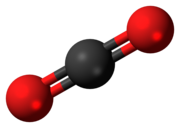CO2
Boiling point: -78.46 °C
Molar mass: 44.01 g/mol
Density: 1.6 g/cm³ (solid); 1.98 kg/m³ (gaseous)
Solubility: 1.45 kg/m³
Summary formula: CO2
Molecular weight: 44.0095 g/mol
Occurrence in nature
Carbon dioxide is a common component of the Earth's atmosphere, and its concentration[4] in the atmosphere varies depending on local conditions, altitude, and relative humidity in the atmosphere. Due mainly to industrial emissions, its average concentration in the air is still growing (see paragraph "The influence of carbon dioxide on global warming").
Locally, there is a very high concentration in places where it erupts from the ground in volcanically active areas and in some natural mineral waters. Due to the fact that it is heavier than air, it can accumulate in such places and represent a dangerous trap for animals and people. Annually, volcanic activities in this way add approximately 130 to 230 Tg to the Earth's atmosphere, which represents only 0.5% of CO2 production by humanity [5].
Carbon dioxide has also been found in interstellar space. It is the main component of the atmospheres of the planets Venus and Mars. It was also proven spectroscopically in comets.
Utilization
Carbon dioxide is an industrially readily available gas. It is used as:
chemical raw material for production:
inorganic carbonates
methanol
polycarbonates
polyurethanes
carbamates
isocyanates
other organic compounds
propellant gas and protective atmosphere for food purposes
part of sparkling drinks
filling of snow extinguishers
cooling medium (dry ice)
in medicine it is added (up to 5%) to oxygen to increase the efficiency of breathing
in aquariums to support the growth of aquarium plants
The effect of carbon dioxide on global warming
CO2 is not inherently harmful because it is not poisonous. At the end of 1997, at the Air Conference held in Japan (Kyoto), the negotiating countries came to accept restrictions on CO2 production. These restrictions are known as the Kyoto Protocol. The increase in CO2 in the air is considered the main cause of global warming, it is mainly caused by the burning of fossil fuels and the loss of forests. Fortunately, so far the most efficient ecosystem sequestering atmospheric carbon dioxide – the marine phytoplankton – is not too disturbed.
A large amount of carbon dioxide is also dissolved in the world's seas and oceans, which thus regulate its amount in the atmosphere. However, the gradual increase in global temperature negatively affects the solubility of CO2 in seawater, and with a positive feedback, another additional amount of this greenhouse gas is released back into the air. Fortunately, most of the carbon dioxide in seawater is bound chemically in the form of carbonate and bicarbonate ions, due to its reaction with calcium minerals according to the equation:
CaCO3 + CO2 + H2O ←→ Ca2+ + 2 HCO3-
However, this balance shifts to the left with increasing temperature.
Also, the intensity of photosynthesis by phytoplankton depends on the optimum temperature and decreases with its growth above the optimum.
Carbon dioxide and biomass
In addition to burning biomass or of biogas, carbon dioxide is also produced during composting. Part of the organic matter remains in the field as crop residues and the root system.
During composting, a large part of the organic matter is transformed into a stabilized organo-mineral fertilizer with a high proportion of humic substances, so that a large proportion of carbon remains fixed in the humus for a long time, which improves the properties of soils (water retention, buffering capacity, etc.). In addition, improved soil properties result in higher yields and thus more intensive assimilation of CO2 during photosynthesis.
Historical connections
Carbon dioxide was the first chemical compound to be described as a gas other than air. In the 17th century, the Flemish chemist Jan Baptist van Helmont discovered that when burning charcoal in a closed vessel, the weight of the ash is less than that of the original coal. He explained this by turning part of the coal into an invisible substance which he called spiritus sylvestre gas.
In the middle of the 18th century, the Scottish physician Joseph Black studied the properties of this gas in more detail. He discovered that heating limestone or reacting it with acids produced a gas that he called "fixed air" because it could be bound by strong bases (e.g. calcium hydroxide). He also discovered that it is heavier than air and that, unlike normal air, it does not support combustion and that animals perish in it. He used binding to calcium hydroxide to prove that it is in exhaled air and also that it is released in the fermentation process.
'

